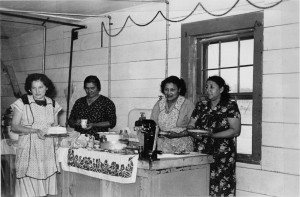
Home Demonstration clubs—also known as Homemakers clubs—were created in 1914 as part of the Cooperative Extension Service in Agriculture and Home Economics. Their goal was to bring “expert” instruction on the subjects of home economics and agriculture to rural women. Originally intended to “uplift” rural women through professional instruction, Home Demonstration clubs became a way for Montana women to socialize and learn from one another and to serve their communities. While the clubs attempted to reinforce conservative domestic values, the experiences of Home Demonstration clubwomen in the post-World War II era suggest that farm women adapted them to their own ends.
At their inception, Homemakers clubs reflected a Progressive-era faith that expertise and government intervention could improve American society. Targeting women who were unable to attend college, Home Demonstration agents instructed women in “scientific” methods of child rearing, food preservation, cooking, consumerism, nutrition, women’s and family health, and home and farm management. Department of Agriculture employee Mary E. Creswell expressed optimism that proper instruction would improve the lives—and character—of rural women: “With increased opportunity for training, . . . and with the opportunity for permanent service in her county, the work of the county woman agent will continue to be the most potent influence for progressive and happy country homes.”